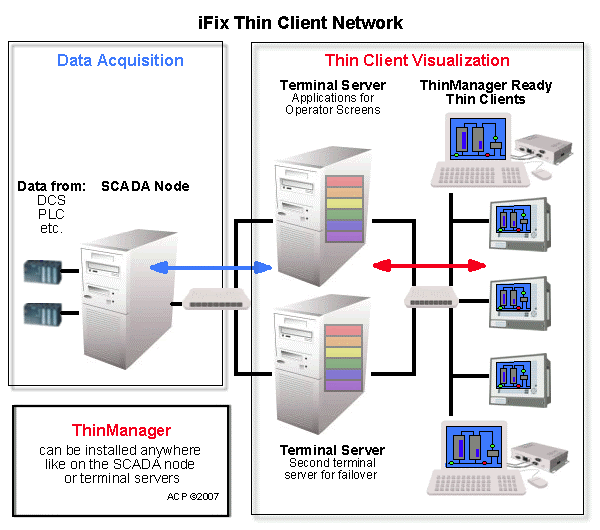|
If you would like to speak with one of our engineers, please Submit a Question or give us a call at the phone number here. In North America, To route your phone support request directly to a technical support engineer, call toll-free 1-888-382-1583 or 1-440-646-3434, select Option 3 (Technical Support), then select Option 5 (More Options). When prompted, enter the ThinManager Direct Dial Code 201. |
Difference between revisions of "IFIX and Terminal Services"
(→Deployment Choices) |
|||
| Line 22: | Line 22: | ||
In a ThinManager system dual terminal servers can be setup to provide redundancy and failover. This allows the operator screens to keep running with current data if a terminal server fails. | In a ThinManager system dual terminal servers can be setup to provide redundancy and failover. This allows the operator screens to keep running with current data if a terminal server fails. | ||
==Deployment Choices== | ==Deployment Choices== | ||
| + | How iFix will be deployed and used influences how iFix is | ||
| + | *Generic Deployment Model– All users use a common SCU file to launch a commonly configured application. | ||
| + | *Specialized Deployment Model – Each user runs a unique environment and each user requires a specially configured SCU file. | ||
| + | This article will assume a generic deployment but will point out where changes need to be made to deploy a specialized configuration.<br> | ||
| + | The generic deployment can be designed to launch a Main Menu with navigational buttons to allow the user to select the needed screens or the welcome screen can have scripts added that launch the desired screens based on the node name of the client.<br> | ||
| + | Consult your iFix documentation for details.<br> | ||
| + | |||
==Microsoft Pre-planning== | ==Microsoft Pre-planning== | ||
===Relaxed Security=== | ===Relaxed Security=== | ||
Revision as of 13:13, 26 October 2012
Contents
Introduction
iFix is a SCADA (System Control and Data Acquisition) software. It was developed by Intellution and is now part of the GE Fanuc Proficy series of industrial software.
This Wiki Article is a simplified deployment guide for ThinManager users. Although it was prepared with the help of iFix users and specialists, it is a mere aid and not the definitive source for information. Please refer to official iFix documentation for questions and details.
A special thanks goes to Scott Crider of Advantage Industrial Automation.
Topics
- Network Configuration
- Deployment Choices
- Microsoft Pre-planning
- iFix Installation
- iFix Licensing
- iFix System Configuration
- Profile Manager
- Launching from within ThinManager
- Additional Microsoft Configurations
Network Configuration
IFix is designed to pull data out of PLCs and factory-level sensors, present the data in a form usable by humans, and save the data for further usage. iFix is designed to function with a “two-box” system.
- The first box is a SCADA (Systems Control And Data Acquisition) computer. This is a PC that gathers the I/O and data from the PLCs and machinery and runs the iFix database. This computer provides the data and values to the system.
- The second box is a View Node. This is a computer that pulls the data from the SCADA node and displays it on screens for the operator.
In a terminal services environment the terminal server acts as the View node. Each client that connects to a terminal server will start a session and launch a view node within the session. The sessions on the terminal server run the operator screens populated with data from the SCADA node.

Sample iFix Network with Thin Clients
In a ThinManager system dual terminal servers can be setup to provide redundancy and failover. This allows the operator screens to keep running with current data if a terminal server fails.
Deployment Choices
How iFix will be deployed and used influences how iFix is
- Generic Deployment Model– All users use a common SCU file to launch a commonly configured application.
- Specialized Deployment Model – Each user runs a unique environment and each user requires a specially configured SCU file.
This article will assume a generic deployment but will point out where changes need to be made to deploy a specialized configuration.
The generic deployment can be designed to launch a Main Menu with navigational buttons to allow the user to select the needed screens or the welcome screen can have scripts added that launch the desired screens based on the node name of the client.
Consult your iFix documentation for details.